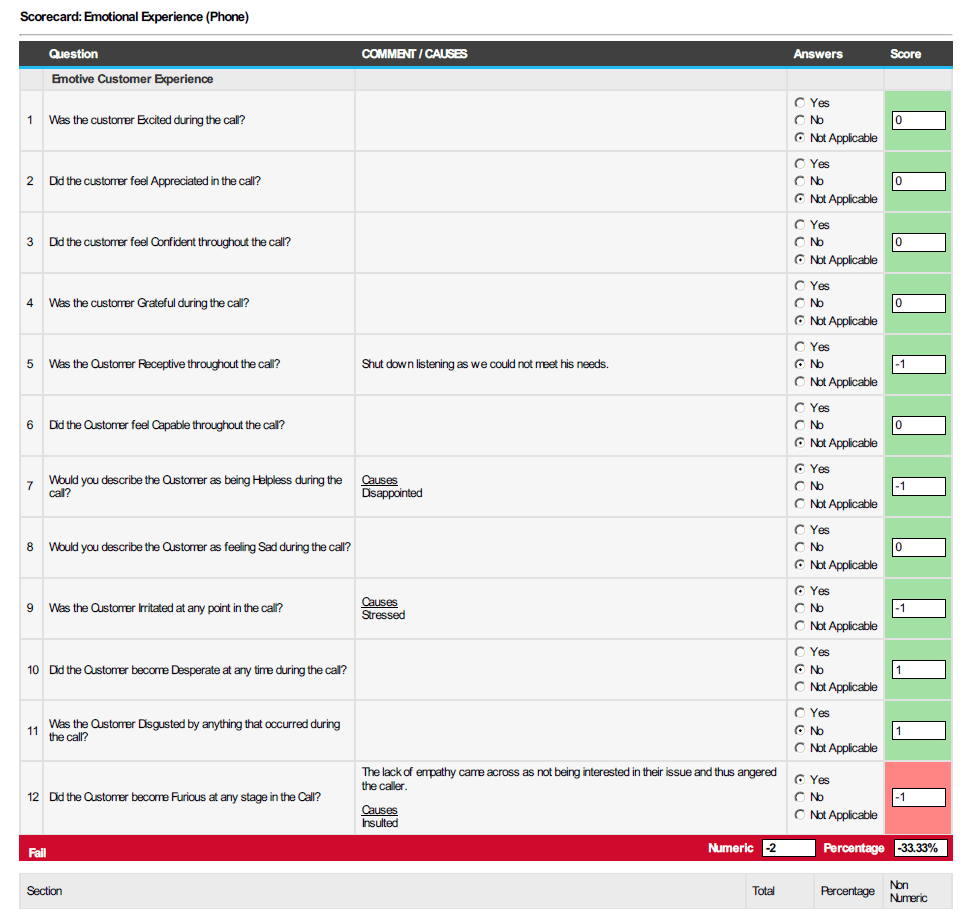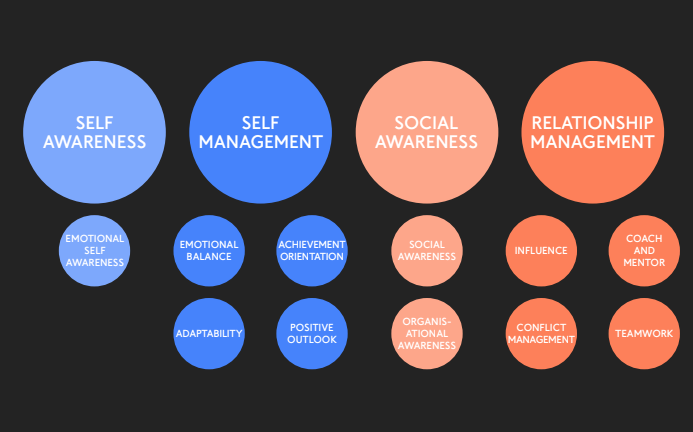Dick Bourke of Scorebuddy talks through the steps you need to take towards improving a negative result from a customer experience.
The impact of emotions on the customer experience cannot be overstated. Over and above the idea of a happy or sad customer, emotions influence customer behaviour in a myriad of ways. In a study of more than 900 customers, researchers found that dissatisfied customers are more likely to complain, switch brands, and talk about their dissatisfaction with others.
That’s what makes Emotive CX such a valuable tool; it provides a framework for measuring and quantifying the emotional impact of a customer’s experience. And by using Emotive CX scorecards, you can get a better handle on how your call centre and service agents are handling your customers’ moods and overall experience.
In our last blog, we talked about the impact of positive emotional scorecards and how you could leverage those successful results to improve your overall Emotive CX. But what happens when you’re dealing with negative results? How can you use them to improve your call centre?
We talked to Martin Hill-Wilson, the global authority on social customer service and co-author of Delivering Effective Social Customer Service, to get his insight into handling and learning from negative scorecards. His experience as a frequent keynote speaker on the topic of Emotive CX makes him the ideal font of information.
Dealing With Emotive CX Failures

Martin Hill-Wilson
“Just because we believe that we can predict the likely emotions in a journey does not mean individual customers will conform. So how we train our teams to ‘actively listen’ and authentically respond really matters.” —Martin Hill-Wilson, Emotive CX for Customer Interaction
Negative experiences – where a customer either ends the call or service with a negative emotional response or where the needle toward positive emotions was not moved as far as it could have been – are learning opportunities for customer-facing teams. The key is to dissect the result of a negative Emotive CX experience and to use that information to improve how the agent, leader, and team respond in the future.
A customer interaction scorecard should be the vehicle that you use to identify negative Emotive CX. You should also look at four key aspects of the customer interaction:
- Quality: Did the call centre employee meet the expected standard?
- Customer: Did the customer have their functional and emotional needs met – did they get what they came for?
- Organisation: Did the company deliver on their value proposition and brand promise through the customer experience?
- Regulator: Did the customer leave with an understanding of what they bought?

Then, once a negative result is identified, you need to open up a dialogue. The goal is to diagnose what went wrong and to talk about what worked and what didn’t. Only then should you implement some type of training programme or coaching intervention that uses the negative scorecard and recorded interaction as a vehicle to improve Emotive CX.
Just make sure that the interaction isn’t viewed in black-and-white terms.
Negative Emotive CX is open to interpretation. Technically, a successful customer interaction could occur when a customer arrives with a negative emotional state and leaves with a negative emotional state – if there was nothing the agent could have done to move the needle toward a positive outcome and all they could do was avoid making the situation worse.
Emotions can’t be pared down to tick boxes or by rote. Directly after a customer interaction, it’s too early to understand why a customer has or hasn’t responded to your agent’s overtures. Instead, you need to go right into diagnostics, using a team approach to discuss what went right and what went wrong.
Diagnosing What Went Wrong
A team approach – which includes the coach, advisor, agent, and customer – can help you better define the areas where an interaction may have fallen short and then decide how to improve. There are as many versions of a situation as there are witnesses. The key is having multiple viewpoints and opinions involved as well as a number of ears listening to pick up clues.
“Quality teams need even more acuity to effectively evaluate and feedback on how emotions influence quality scores and assessments,” Hill-Wilson said in Emotive CX for Customer Interaction.
The truth is that every individual processes reality in highly different ways, so the more people who can use a framework to diagnose why a customer interaction was negative, the better. And debate, rather than an overly prescriptive programme, should be used to move forward.
There is a very simple, four-question structure to diagnosing what went wrong:
- What was the customer’s story and situation?
- Was the customer’s emotional state recognised at the beginning?
- In what emotional state did the customer leave the interaction?
- What was done over the course of the interaction to move the needle – either forward or backward?
What was the customer’s backstory and situation?
“Use narrative not scales to measure emotional content. The reason for this goes back to anthropology: in interpreting our experiences, customers use stories. For instance, no one walks out of a store and says that was a great 8.5 out of 10 experience, and no one evaluates each and every detail of their experience.” —Martin Hill-Wilson, Emotive CX for Customer Interaction
To obtain positive Emotive CX, you need to have a conversation with customers, not just a one-way pitch. By taking the time to discuss whether or not the agent understood the customer’s story, you can immediately begin to see where and how things might have gone wrong.
This backstory is also vital information necessary for understanding the customer’s emotional state.
For example, let’s say Customer #1 called in because their power was down for 24 hours with no explanation while Customer #2 was in the same situation but they knew their power was down due to a storm that knocked over a tree in their yard. In both cases, the customer may feel dissatisfied by being without power, but the unknown situation of Customer #1 could also add feelings of frustration and even anger that would need to be identified and dealt with.
Did we recognise the customer’s beginning emotional state?
“There is a fierce debate amongst speech analytic experts about the art of the possible. Can emotion be accurately identified even with customer context and intent?” —Martin Hill-Wilson, Emotive CX for Customer Interaction
Even knowing the backstory of your customer, determining feelings can be a challenge. This is where the team approach is vital. If the customer interaction was recorded, the team should listen to the recording multiple times until it’s possible to pick out the emotional nuances of the conversation. Then, they should agree on the emotional state of the customer at the very beginning of the conversation.
If the agent got the initial emotional state wrong, then the remainder of the interaction would have been founded on this erroneous assumption, affecting the Emotive CX negatively.
In what emotional state did the customer leave?
“It begins by knowing what you want the customer to feel at the end of the journey, which psychologists tell us is one of the most influential moments in framing how a customer will generate an abiding memory of their service or sales experience.” —Martin Hill-Wilson, Emotive CX for Customer Interaction
It’s not just how the customer feels at the beginning of the interaction that’s important, it’s how they feel at the end after the interaction. How did the customer come away feeling? Was the needle moved toward a positive or negative response and how far did the needle move?
To determine this information accurately, you might ask the customer to fill out a survey at the end of the interaction. Or you may decide to call the customer back and ask for their feedback on the interaction and how they felt by the end. If neither is possible, the recording can be used to determine the feelings at the end of the conversation.
What was done over the course of the conversation to get that result?
“As a goal, we want our teams to be able to improve customer outcomes by raising their awareness of the emotional content within interactions and their skill in addressing how a customer feels. This applies as much to sales as to service. The challenge is that while some emotions are consciously experienced, others play beneath the surface.” —Martin Hill-Wilson, Emotive CX for Customer Interaction
If you determined the needle was moved for good or for ill in the last question, this is then when you discuss what was done during the interaction to cause that result. You should ask questions such as, “Were they sensitive and facilitative?” “Did they listen well or poorly?” “Did they ask the right questions?” Your goal should be to take an in-depth look at how the agent interacted with the customer and what the result of those interactions was.
Using Negative Scorecards to Develop Empathy
“Empathy manifests itself through good listening, demonstrating that the company knows the customer as an individual, interest in the customer’s issue and a willingness to shape the company’s response around the needs of the customer. The outcome of empathy, when executed well and followed through, is a customer-shaped response, rather than a generic one.” —Derek Eccleston, expert services director at MaritzCX
Once you’ve diagnosed a negative Emotive CX and determined why it occurred, it’s time to build a better approach to your call centre or service interactions. The key is empathy, which is a skill you need to practise over and over again.
Think of it as training your call centre agents to develop a solid emotional quotient (EQ), the ability to recognise their own emotions and those of others and discern the difference between feelings. This theory was popularised by Daniel Goleman and includes everything from self-awareness to self-management, social awareness, and relationship management.
Not everything outlined in the diagram below will be relevant to developing empathy in your call centre, but it offers an idea of the skills required to be a successful agent and creates a template for leveraging negative scorecards in Emotive CX skill building.

Just remember to be cautious with your coaching approach. You’ll need to be sensitive to your agents and provide the necessary time and space to get the job done right. At the end of the day, you want your agents to be able to sit in the customer’s shoes in a real way. That’s how you’ll improve Emotive CX.
Training Your QA Team for Improved Emotive CX
Here are three ideas for training your team:
Role-playing
Agent role-playing is a great way to practise Emotive CX in call centres. Using various role-playing scenarios, you can test how well an agent recognises emotional nuances and demonstrate how to move the needle toward a positive result. By letting the agents take part in the action, they can get virtually every question answered and learn to tweak their interactions for the best results.
Talk to the Customer
Don’t be afraid to talk to customers who’ve had a negative experience to get their feedback. This is a great opportunity to learn the most about what does and doesn’t matter to your customers and so how you can change your interactions to best meet their needs. Just remember, every customer is unique, so don’t take one customer’s opinion as gospel.
Workshopping
Finally, on-site workshops are a great way to provide skills, ideas, and techniques for the entire customer service team. During a workshop, your managers, advisors, and coaches can cover multiple negative and positive scorecard results and dissect each interaction to highlight the good and the bad results. This can help you improve communication skills, listening, problem-solving, and managing difficult customers.
You Can Turn the Negative Into a Positive

Dick Bourke
Just because a customer interaction goes poorly doesn’t mean it was a wasted opportunity. It’s when things fail that you have the greatest opportunity to learn and improve the call centre customer experience.
Next time you find a negative scorecard result, take that as the perfect training opportunity to improve Emotive CX across all of your customer service interactions. The bottom line is that even when a customer walks away unhappy, you can find a way to use it for good.
This blog post has been re-published by kind permission of Scorebuddy – View the Original Article
For more information about Scorebuddy - visit the Scorebuddy Website
Call Centre Helper is not responsible for the content of these guest blog posts. The opinions expressed in this article are those of the author, and do not necessarily reflect those of Call Centre Helper.
Author: Scorebuddy
Published On: 7th Feb 2019 - Last modified: 19th Aug 2024
Read more about - Guest Blogs, Martin Hill-Wilson, Scorebuddy






 Scorebuddy is quality assurance solution for scoring customer service calls, emails and web chat. It is a dedicated, stand-alone staff scoring system based in the cloud, requiring no integration.
Scorebuddy is quality assurance solution for scoring customer service calls, emails and web chat. It is a dedicated, stand-alone staff scoring system based in the cloud, requiring no integration. 





























